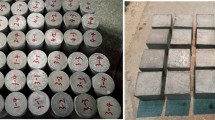Abstract
In this study, radon (222Rn) measurements were taken at compacted uranium tailings with cover materials by a self-developed coupling testing system under different low-frequency vibration loads and gas seepage rates. The maximum measured value appears at 0.723 Bq m−2 s−1, which is close to the upper limit value of national standard of China (0.74 Bq m−2 s−1). A vibration load significantly damages the compacted uranium tailings sample structure, resulting in a marked increase in the porosity of the porous media thus forming a channel for radon migration. The results presented here may provide a workable approach for simulating geological dynamic load conditions for radon exhalation studies on uranium tailings impoundment.














Similar content being viewed by others
References
World Health Organization (2010) WHO handbook on indoor radon a public health perspective
IAEA Publications (2013) Measurement and calculation of radon releases from uranium mill tailings
Landa ER (1987) Radium-226 contents and rn emanation coefficients of particle-size fractions of alkaline, acid and mixed u mill tailings. Health Phys 52:303–310. https://doi.org/10.1097/00004032-198703000-00004
Etiope G, Martinelli G (2002) Migration of carrier and trace gases in the geosphere: an overview. Phys Earth Planet Inter 129:185–204. https://doi.org/10.1016/S0031-9201(01)00292-8
Hu N, Ding D, Li G et al (2014) Vegetation composition and 226 Ra uptake by native plant species at a uranium mill tailings impoundment in South China. J Environ Radioact 129:100–106. https://doi.org/10.1016/j.jenvrad.2013.12.012
Monkul MM, Yamamuro JA (2011) Influence of silt size and content on liquefaction behavior of sands. Can Geotech J 48:931–942. https://doi.org/10.1139/t11-001
Psarropoulos PN, Tsompanakis Y (2008) Stability of tailings dams under static and seismic loading. Can Geotech J 45:663–675. https://doi.org/10.1139/T08-014
Ferry C, Richon P, Beneito A, Robé MC (2001) Radon exhalation from uranium mill tailings: experimental validation of a 1-D model. J Environ Radioact 54:99–108. https://doi.org/10.1016/S0265-931X(00)00169-7
Sahoo BK, Mayya YS, Sapra BK et al (2010) Radon exhalation studies in an Indian uranium tailings pile. Radiat Meas 45:237–241. https://doi.org/10.1016/j.radmeas.2010.01.008
Tan K, Liu Z, Xia L et al (2012) The influence of fractal size distribution of covers on radon exhalation from uranium mill tailings. Radiat Meas 47:163–167. https://doi.org/10.1016/j.radmeas.2011.11.010
Li Y, Tan W, Tan K et al (2018) The effect of laterite density on radon diffusion behavior. Appl Radiat Isot 132:164–169. https://doi.org/10.1016/j.apradiso.2017.12.001
Savovic S (2011) Explicit finite difference solution of the diffusion equation describing the flow of radon through soil. Appl Radiat Isot 69:237–240. https://doi.org/10.1016/j.apradiso.2010.09.007
Sakoda A, Ishimori Y, Hanamoto K et al (2010) Experimental and modeling studies of grain size and moisture content effects on radon emanation. Radiat Meas 45:204–210. https://doi.org/10.1016/j.radmeas.2010.01.010
Leonardi F, Bonczyk M, Nuccetelli C et al (2018) A study on natural radioactivity and radon exhalation rate in building materials containing norm residues: preliminary results. Constr Build Mater 173:172–179. https://doi.org/10.1016/j.conbuildmat.2018.03.254
Ye YJ, Dai XT, Ding DX, Zhao YL (2016) Modeling and experimental examination of water level effects on radon exhalation from fragmented uranium ore. J Environ Radioact 165:219–226. https://doi.org/10.1016/j.jenvrad.2016.10.009
Immé G, Catalano R, Mangano G, Morelli D (2014) Radon exhalation measurements for environmental and geophysics study. Radiat Phys Chem 95:349–351. https://doi.org/10.1016/j.radphyschem.2013.02.033
Vaupotiĉ J, Gregoriĉ A, Kobal I et al (2010) Radon concentration in soil gas and radon exhalation rate at the Ravne fault in NW Slovenia. Nat Hazards Earth Syst Sci 10:895–899. https://doi.org/10.5194/nhess-10-895-2010
Perrier F, Girault F (2012) Measuring effective radium concentration with less than 5 g of rock or soil. J Environ Radioact 113:45–56. https://doi.org/10.1016/j.jenvrad.2012.04.010
ISO 11665e7:2012 (2012) Measurement of radioactivity in the environment-air: radon-222-Part 9: Test methods for exhalation rate of building materials
Zhang L, Lei X, Guo Q et al (2012) Accurate measurement of the radon exhalation rate of building materials using the closed chamber method. J Radiol Prot 32:315–323. https://doi.org/10.1088/0952-4746/32/3/315
Awhida A, Ujić P, Vukanac I et al (2016) Novel method of measurement of radon exhalation from building materials. J Environ Radioact 164:337–343. https://doi.org/10.1016/j.jenvrad.2016.08.009
Hong C, Li X, Zhao G et al (2018) Preparation and multi-properties determination of radium-containing rocklike material. IOP Conf Ser Earth Environ Sci 121:52018. https://doi.org/10.1088/1755-1315/121/5/052018
Feng SY, Wang HQ, Cui Y et al (2019) Monte Carlo method for determining radon diffusion coefficients in porous media. Radiat Meas 126:106130. https://doi.org/10.1016/j.radmeas.2019.106130
International Atomic Energy Agency (IAEA) (2004) Final report of a co-ordinated research project 2000–2004: The long term stabilization of uranium mill tailings. Vienna
Wang L, Ye Y, Ding D et al (2014) Experimental study on radon seepage migration and exhalation laws in fragmented emanation media. At Energy Sci Technol 48:1718–1724 (In Chinese)
Planinić J, Radolić V, Vuković B (2004) Radon as an earthquake precursor. Nucl Instruments Methods Phys Res Sect A Accel Spectrometers, Detect Assoc Equip 530:568–574. https://doi.org/10.1016/j.nima.2004.04.209
Kemski J, Klingel R, Siehl A, Valdivia-Manchego M (2009) From radon hazard to risk prediction-based on geological maps, soil gas and indoor measurements in Germany. Environ Geol 56:1269–1279. https://doi.org/10.1007/s00254-008-1226-z
Acknowledgements
The authors are thankful to the Hunan Province Engineering Technology Research Center of Uranium Tailings Treatment, China, for providing the experimental site and processed samples. And this study was supported by the National Natural Science Foundation of China (Grant No. 11475081).
Author information
Authors and Affiliations
Corresponding authors
Ethics declarations
Conflict of interest
The authors declare that they have no known competing financial interests or personal relationships that could have appeared to influence the work reported in this paper.
Additional information
Publisher's Note
Springer Nature remains neutral with regard to jurisdictional claims in published maps and institutional affiliations.
Rights and permissions
About this article
Cite this article
Cai, Z., Zhang, Q., Li, X. et al. Research on radon exhalation characteristics of uranium tailings with cover materials under the coupling load of low-frequency vibration and seepage gradient. J Radioanal Nucl Chem 327, 359–371 (2021). https://doi.org/10.1007/s10967-020-07478-x
Received:
Accepted:
Published:
Issue Date:
DOI: https://doi.org/10.1007/s10967-020-07478-x




